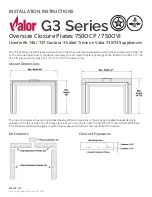
Installation
900079-02J, 05/2019
Innovative Hearth Products
DRL3000 Linear Direct-Vent Gas Fireplaces
29
Install the Horizontal Termination Vent System
These instructions should be used as a guideline and do not supersede local codes in any way. Install venting with
the most restrictive requirements as outlined in these instructions, local codes, these instructions, the current
National Fuel Gas Code (ANSI-Z223.1) in the USA or the current standards of CAN/CGA-B149.1 in Canada.
Ensure clearances are in accordance with local installation codes and the requirements of the gas supplier.
Dégagement conforme aux codes d’installa tion locaux et aux exigences du foumisseunde gaz.
Horizontal vent systems terminate through an outside wall. Building Codes limit or prohibit terminating in specific
areas
(
Table 7
).
The following figures and their associated horizontal vent tables illustrate the various configurations that are possible
for use with these fireplaces. Secure Vent
®
pipe is shown in these figures; Secure Flex
®
pipe may also be used.
A table summarizes each configuration’s minimum and maximum vertical and horizontal length parameters for a
variety of applications. For more information on connecting the vent pipe, see
Page 22
.
Assure that adequate space between the bottom of the horizontal run and the attic is provided so that blown in
insulation does not contact the vent.
Building
support
framing
Horizontal
support
brackets
90° Elbow
Vertical
rise
Ceiling
Vertical
firestop /
spacer
u
Horizontal
termination
Exterior
wall
Support vertical venting every 8
ft (2.4 m) above fireplace vent
outlet.
Horizontal/inclined run
Place horizontal support brackets
every 5 ft (1.524 m).
Fireplace
Straight vent
sections
Horizontal
firestop /
spacer
u
Horizontal
termination
Figure 23 - Typical Horizontal Vent Installation
1. Analyze the vent route and determine the number of vent sections and elbows required
—See
Effective Vent
Length on
Pages 22-23
for more information. Plan the venting so that a joint does not occur in the ceiling or
roof joists. Allow for elbows
(
Figure 16
)
. Maintain clearances to combustibles equal to or greater than minimum
specified in these instructions
(
Page 24
)
.
2. Frame the exterior wall opening
—Locate the center of the vent outlet on the exterior wall
(
Table 10
)
. Cut and/
or frame an opening, 10-1/2 x 12-1/8” (267 x 308 mm) inside dimensions, about this center. Horizontal firestop/
spacer must be used anywhere vent pipe passes through a combustible wall.
3. Frame the ceiling opening
—If the vertical route is to penetrate a ceiling, use plumb line to locate the center
above the fireplace. Cut and/or frame an opening, 10-1/2 x 10-1/2” (267 x 267 mm) inside dimensions, about
this center
(
Figure 21
)
.
4. Attach the vent components to the fireplace
—See
Connecting the vent pipe on
Page 22
.
5. Attach the vent components to each other
—See
Connecting the vent pipe on
Page 22
.
u
Vertical firestop/spacer must be used anywhere vent pipe passes through a combustible floor or ceiling. Horizontal firestop/
spacer must be used anywhere vent pipe passes through a combustible wall.
v
Install the provided vent restrictor, if required.
NOTE: A 90° elbow may NOT be attached directly to the appliance collar. A minimum 6” pipe section must be used between the
fireplace collar and a 90° elbow.
v
v
















































